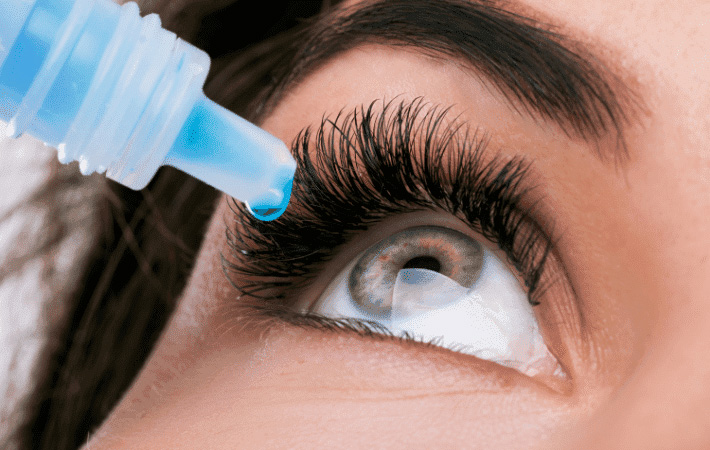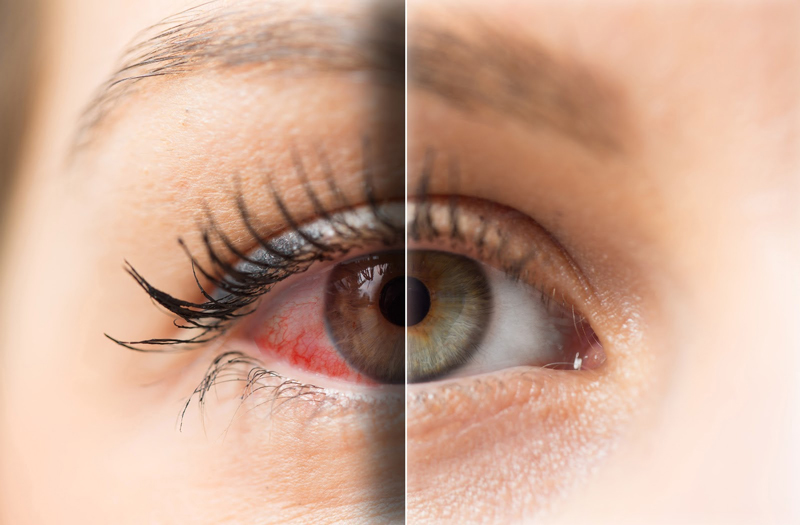
If you suffer from dry eye disease, you probably know about the standard treatment options: dry eye therapy and eye drops. But how do you know which eye drops to choose?
Searching for eye drops, also known as artificial tears, can be overwhelming. How do you know what type of eye drops are suitable for your symptoms? How do you pick between all the brands on the shelf? If you don’t know where to start, you’re not alone.
With 5-15% of the American population suffering from dry eye, we decided it was time to put together a comprehensive guide covering everything dry eye!
WHAT IS DRY EYE?
Dry eye disease is a common condition caused by insufficient tear production (known as aqueous deficiency dry eye) or low tear volume (known as evaporative dry eye). When your tears aren’t working, they cannot properly lubricate your eyes, leading to inflammation and damage to the eye’s surface.
Dry eyes feel uncomfortable, and you may feel a stinging or burning sensation. Dry Eye can be a stable condition, or you can experience it from time to time in certain situations, such as looking at a computer screen or after being on an airplane.
Although there are no permanent cures for dry eyes, you can manage your symptoms to make your eyes feel more comfortable. These treatments can include lifestyle changes, eye drops and dry eye therapy.
CAUSES OF DRY EYE
There are two leading causes of dry eye: inadequate tear production and poor tear quality.
Inadequate Tear Production
For your tears to function the way they’re supposed to, your body needs to produce the right amount. If your tear production is low, your eyes can become dry and irritated.
There are many reasons why your eyes might not produce enough tears. Common causes of inadequate tear production include:
- Old age
- Vitamin A deficiency
- Certain medical conditions, such as diabetes, arthritis, allergies, or infections
- Damage to your tear glands
- Side effects from eye surgeries
POOR TEAR QUALITY
For your eyes to be healthy, you need to have healthy tear film. Your tear film is made of a mixture of water, oils, and mucus that cover the eyes’ surface, hydrating and protecting them. If your tears lack any of these components, they are considered poor quality and can cause dry eyes.
Common causes of poor tear quality include:
- Medications
- A change in physical activity
- Poor diet
- A change in environment

DRY EYE SYMPTOMS
Dry eye disease usually affects both eyes, but can affect only one eye at a time as well. Common symptoms of dry eye include:
- A stinging, burning or scratchy sensation in your eyes
- An abnormal amount of mucus in or around your eyes
- Eye redness
- Sensitivity to light
- The feeling of having something in your eyes
- Difficulty wearing contact lenses
- Difficulty with nighttime driving
- Watery eyes
- Blurred vision
- Eye fatigue
WHEN TO SEE A DOCTOR
You should book an appointment for an eye exam or see your doctor if you are experiencing prolonged or severe symptoms.
CHOOSING THE RIGHT EYE DROPS
Identifying the Cause of Your Dry Eye
The first step in finding the proper treatment is getting the right diagnosis. Book an appointment with your eye doctor to receive an eye exam to identify the cause of your dry eye.
Knowing the Different Types of Artificial Tears
Once you know what is causing your dry eye, you will have an easier time choosing which artificial tears are suitable for you.
There are three main types of artificial tears, each useful for different causes of dry eye. These three types are:
- Tear Changing: These artificial tears have ingredients that change the chemical make-up of your tears. If your dry eye disease is caused by poor tear quality, these may be the right option for you.
- Eye Coating: These artificial tears have ingredients that improve the moisture content in your eye. If evaporative dry eye is your problem, eye coating artificial tears may offer you the relief you’re looking for.
- Oil Stabilizing: Some artificial tears aim to stabilize the oil part of the tear film. If your tear film is lacking the oil component, it causes your tears to evaporate. If your doctor diagnoses you with evaporative dry eye due to improper oil production, you should use oil-stabilizing artificial tears.
WITH OR WITHOUT PRESERVATIVES?
After understanding what type of artificial tears are needed, your next step is deciding whether you want eye drops with or without preservatives. Preservatives are added to eye drops to keep them shelf-stable after you open them.
Although preservatives won’t bother most people, people with sensitive eyes, or people who need to use eye drops more than four times daily, should opt for preservative-free options.
DON’T COMMIT TO ONE BRAND
No one knows your eyes as you do. Therefore, the best way to find the right artificial tears for you is by trying multiple different brands to find which one offers you the most relief.
USING ARTIFICIAL TEARS
If you have been diagnosed with dry eye and are unsure how to use Artificial tears, follow these steps to ensure you’re using them correctly:
- Tilt your head back
- Look up, and pull out your lower eyelid to make a “pouch”
- Place the dropper directly over the eye and squeeze out 1-2 drops or as recommended by your eye doctor
- Look down and gently close your eye for 1-2 minutes
If you have any questions about dry eye, symptoms, or treatment options, contact us today!

 Dr. Phillips earned his Bachelor of Science in Chemistry at the University of Georgia before achieving his Doctor of Optometry from the Southern College of Optometry. There, he served as Vice President of the Georgia Optometric Student Association and provided free and cost-reduced optometric care to underserved patients in Mexico and Belize with the Student Volunteer Optometric Services to Humanity. He served his residency at Gainesville Eye Associates, focusing on ocular diseases.
Dr. Phillips earned his Bachelor of Science in Chemistry at the University of Georgia before achieving his Doctor of Optometry from the Southern College of Optometry. There, he served as Vice President of the Georgia Optometric Student Association and provided free and cost-reduced optometric care to underserved patients in Mexico and Belize with the Student Volunteer Optometric Services to Humanity. He served his residency at Gainesville Eye Associates, focusing on ocular diseases. Dr. Morgan Kickliter grew up in Hendersonville, Tennessee.
Dr. Morgan Kickliter grew up in Hendersonville, Tennessee. After growing up in Minersville, Pennsylvania, Dr. Price graduated from Susquehanna University in 2012 with a Bachelor’s Degree in Biology. Dr. Price continued her education at the Pennsylvania College of Optometry and completed her training in 2016. After graduation, Dr. Price spent her career studying advanced eye diseases and specialized Low Vision services and devices.
After growing up in Minersville, Pennsylvania, Dr. Price graduated from Susquehanna University in 2012 with a Bachelor’s Degree in Biology. Dr. Price continued her education at the Pennsylvania College of Optometry and completed her training in 2016. After graduation, Dr. Price spent her career studying advanced eye diseases and specialized Low Vision services and devices. Dr. Kapadia graduated with honors from the Michigan College of Optometry in 1999, where she received the Wesley-Jessen award for Outstanding Work in Contact Lenses. During her studies, she also served as President of Student Volunteer Optometric Services to Humanity (SVOSH), which works to improve the sight of millions of people in developing countries.
Dr. Kapadia graduated with honors from the Michigan College of Optometry in 1999, where she received the Wesley-Jessen award for Outstanding Work in Contact Lenses. During her studies, she also served as President of Student Volunteer Optometric Services to Humanity (SVOSH), which works to improve the sight of millions of people in developing countries. Dr. Kapadia originally hails from St. Catharines, Ontario, Canada where he earned his Bachelor of Arts degree from Brock University. He then went on to graduate with honors from the Michigan College of Optometry in 1998, where he specialized in contact lenses. After he graduated, Dr. Kapadia completed a one-year residency at the renowned Bascom Palmer Eye Institute in Miami, Florida, where he focused on ocular diseases.
Dr. Kapadia originally hails from St. Catharines, Ontario, Canada where he earned his Bachelor of Arts degree from Brock University. He then went on to graduate with honors from the Michigan College of Optometry in 1998, where he specialized in contact lenses. After he graduated, Dr. Kapadia completed a one-year residency at the renowned Bascom Palmer Eye Institute in Miami, Florida, where he focused on ocular diseases.